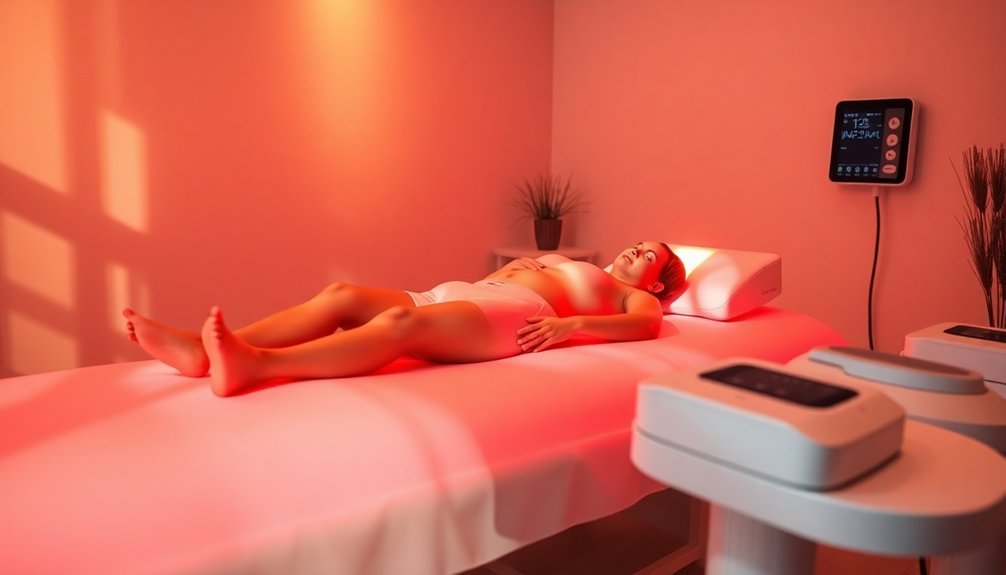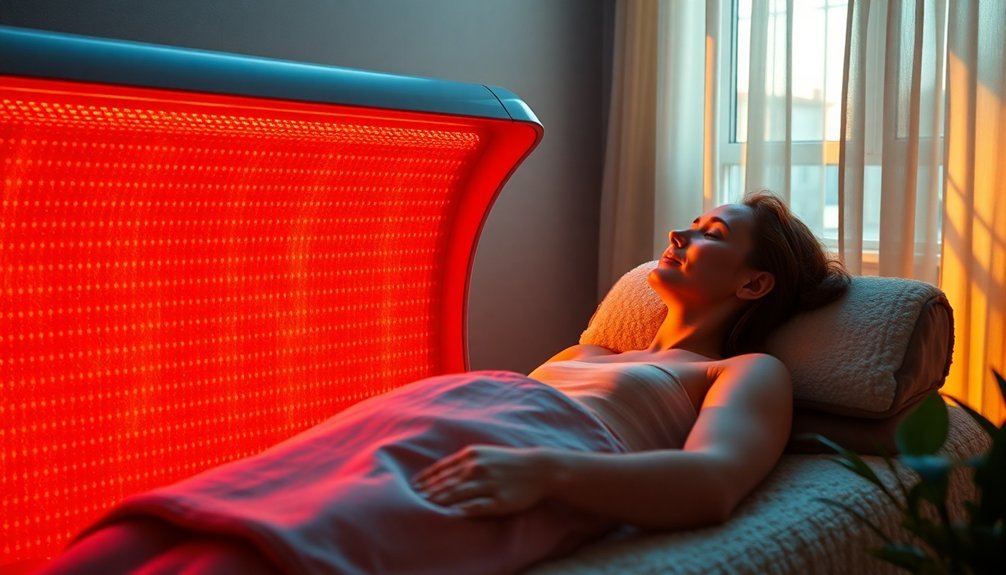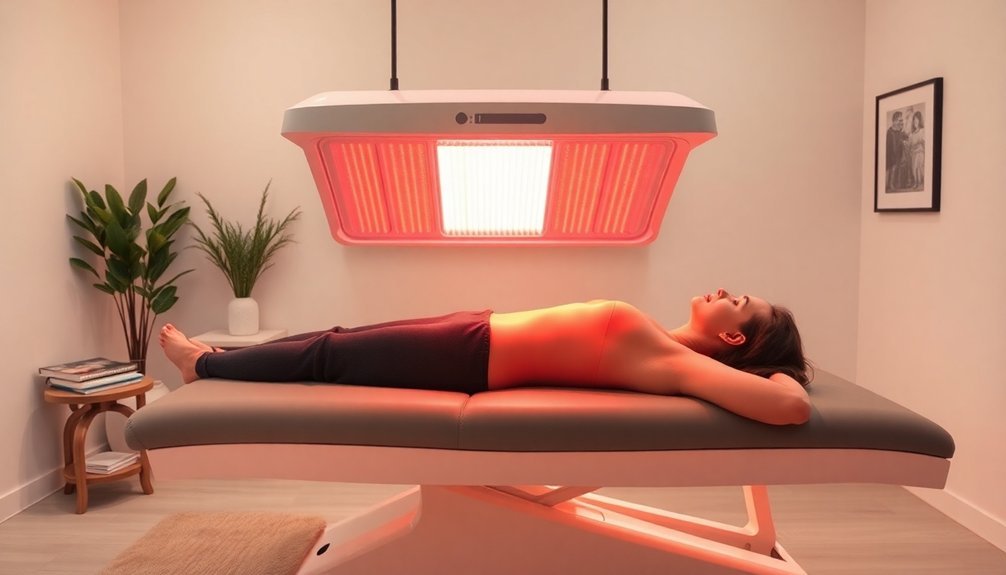To reduce heart inflammation with infrared therapy, start with 15 minutes in a far infrared sauna set at 60°C/140°F. Follow this by wrapping yourself in a blanket for 30 minutes. Aim for at least two sessions a week, or daily for severe cases. Hydric balance is essential, so drink water before and after your session. This therapy boosts circulation and reduces inflammatory markers, such as IL-6 and C-reactive protein, promoting better heart health. By implementing this protocol, you can support your body's healing process, and there are plenty of additional tips to enhance your results available.
Mechanisms of Infrared Therapy

Infrared therapy works by penetrating deep into tissues, reaching up to 1.5 inches beneath the skin. It utilizes far infrared (FIR) wavelengths, which, while not visible to the eye, are felt as gentle heat. This absorption triggers metabolic activities at a cellular level, converting infrared light energy into cellular energy and stimulating your mitochondria to produce ATP, the energy currency of your cells.
As infrared light penetrates your skin, it causes local cutaneous vasodilation. This means your blood vessels expand, aided by chemical vasodilators like histamine. You'll also experience reflex dilation in other vessels, helping maintain your body's heat balance.
As blood flow increases, nitric oxide production promotes relaxation of arteries, delivering essential nutrients and oxygen to any damaged areas. Additionally, the absorption of water and protein in your tissues facilitates deeper penetration of infrared waves, enhancing the overall therapeutic effects.
Moreover, the ATP production stimulated by infrared therapy supports your cells in repairing damage and regenerating confidently. Collagen production is also influenced, providing structure and support across various tissues.
Protocol for Effective Treatment
Utilizing a structured protocol for infrared therapy guarantees you receive the most effective treatment for heart inflammation. Follow this plan to maximize your results:
| Step | Details |
|---|---|
| Treatment Duration | 15 minutes in a far infrared sauna |
| Followed by 30 minutes wrapped in a blanket | |
| Temperature Settings | Sauna at 60°C/140°F, cabin air ≤ 40°C |
| Frequency | At least twice weekly; daily for 10 days in severe cases |
| Hydration | Consume water before and after treatment |
| Monitoring | Check body temperature and hydration status |
Before treatment, position yourself comfortably and make sure the area is exposed. Test thermal sensations and shield your eyes. It is essential to note that infrared sauna therapy can reduce inflammation and improve blood circulation, key factors in fighting heart disease. Post-treatment, maintain warmth with a thermal blanket while monitoring for any adverse reactions.
Adhering to this protocol not only enhances your experience but also supports your health journey effectively. Remember, safety is vital; always stay attentive to your body's responses during treatment.
Enhancing Vascular Health

When you engage in infrared therapy, you can experience improved blood circulation, which enhances the delivery of oxygen and nutrients throughout your body. This therapy also helps reduce inflammation markers, promoting better overall vascular health. Additionally, it supports endothelial function, essential for maintaining flexible and responsive blood vessels. Furthermore, studies have shown that infrared therapy can significantly increase blood flow, providing cardiovascular conditioning that benefits your heart's health.
Improved Blood Circulation
Enhanced blood circulation is crucial for maintaining vascular health, and infrared therapy offers a compelling solution. With this innovative therapy, you can experience a remarkable rise in blood flow, often increasing from 5-7 quarts per minute to as much as 13 quarts per minute.
This enhanced circulation mimics the benefits of a passive cardiovascular workout, keeping your blood vessels healthy even after the session ends.
The benefits of improved blood circulation are numerous and impactful:
- Increased oxygen and nutrients nourish your tissues, accelerating healing and recovery.
- Better blood flow protects against blood clotting, promoting longevity in your body's overall health.
- Regular sessions can even lower blood pressure, giving you a sense of well-being.
Also, far infrared therapy stimulates the production of nitric oxide, which relaxes your arteries and enhances blood vessel function.
This means better delivery of nutrients and oxygen to your muscles and skin, helping to improve both appearance and recovery.
Reduced Inflammation Markers
While improved blood circulation plays a significant role in overall vascular health, addressing inflammation is equally important. Far infrared (FIR) therapy effectively reduces inflammatory markers, making it a valuable tool for enhancing your vascular health.
By inducing heme oxygenase-1 (HO-1), FIR therapy minimizes the expression of proinflammatory cytokines like IL-6 and TNF-alpha, which are linked to cardiovascular risk. Elevated IL-6 levels can increase C-reactive protein (CRP), further contributing to vascular inflammation.
Fortunately, FIR therapy helps lower these markers, decreasing your likelihood of experiencing future cardiovascular events. You'll find that the therapy inhibits the expression of adhesion molecules like E-selectin and ICAM-1, reducing overall vascular inflammation.
Moreover, FIR therapy impacts various inflammatory markers, helping lower neutrophil/lymphocyte ratios and fibrinogen levels. By effectively targeting these markers, it can improve your endothelial health and promote better blood flow.
With consistent FIR therapy, you'll likely see a significant reduction in inflammatory status, contributing to a healthier vascular system and lowering your risk of heart inflammation.
Enhanced Endothelial Function
To boost your vascular health, optimizing endothelial function is essential. Infrared therapy offers a powerful mechanism by delivering light photons that penetrate your skin and interact with hemoglobin in your red blood cells. This interaction releases nitric oxide, promoting blood vessel relaxation and increasing blood flow to the treated area.
As a result, more oxygen and glucose reach your endothelial cells, improving energy production and overall vascular integrity.
Using infrared therapy can yield several emotional benefits:
- Feel revitalized as enhanced circulation increases your energy levels.
- Experience peace of mind knowing you're taking proactive steps for your cardiovascular health.
- Embrace a brighter future by potentially mitigating age-related declines in arterial health.
This treatment can be particularly effective for areas with compromised blood flow, making it a valuable complement to regular physical activity.
While exercise is crucial for overall fitness, infrared therapy specifically focuses on localized, targeted improvements. Together, they create a robust strategy for enhancing vascular health, especially if you face challenges related to age or conditions like heart failure or diabetic neuropathy.
Investing in this therapy could be a significant step towards a healthier you.
Benefits for Heart Failure
Infrared therapy offers substantial benefits for those grappling with heart failure, shedding light on new ways to improve their condition.
With consistent usage, you can experience a remarkable 50% lower risk of fatal heart disease and a 60% reduced risk of sudden cardiac death. Additionally, your rates of hospitalization may drop considerably over five years.
One of the most immediate advantages you might notice is enhanced exercise ability. Infrared therapy supports better cardiac output, allowing for greater walking capacity.
You'll find that your overall quality of life can improve, as studies indicate better mental health and cardiovascular function among those with chronic heart failure.
This therapy also promotes improved vascular endothelial function, which is essential for heart health.
By decreasing vascular resistance, infrared therapy helps dilate your arteries and veins, facilitating smoother blood flow.
You'll benefit from increased nitric oxide production as well, further boosting vascular function.
Reducing Inflammation and Fibrosis

Heart failure can lead to varying degrees of inflammation and fibrosis, both of which greatly impact the heart's ability to function at its best. Infrared therapy offers compelling benefits to help combat these issues. It decreases inflammatory markers like cytokines and histamines in your bloodstream, promoting healthier vascular function.
With treatments like Waon therapy, studies show significant reductions in inflammation, benefiting those with coronary risk factors.
Here's how infrared therapy can help you:
- You can breathe easier knowing that reduced inflammation translates to better heart function.
- Imagine fewer hospital visits and a lower risk of severe heart problems.
- Feel the relief from improved circulation and overall well-being.
The mechanisms at play, such as increased nitric oxide production, work to dilate your blood vessels and enhance blood flow. This reduction in systemic vascular resistance helps relieve the strain on your heart.
Red light therapy also plays a role in reducing oxidative stress in heart tissue. With these powerful effects, you can reclaim a healthier heart and improve your quality of life. Embracing infrared therapy could be a transformative step on your journey toward heart health.
Improving Cellular Repair
One powerful way to enhance cellular repair is through the application of infrared therapy. By stimulating your mitochondria, infrared light increases adenosine triphosphate (ATP) production, boosting your cells' energy levels. This surge in energy accelerates cellular metabolism, enabling damaged cells to repair and regenerate more efficiently.
With improved mitochondrial function, oxidative stress decreases, promoting overall cellular health.
Additionally, infrared therapy triggers the release of nitric oxide, which relaxes your arteries, enhancing blood circulation. Better circulation delivers essential nutrients and oxygen to your tissues, essential for healing. This process also prevents platelet clumping and regulates blood pressure, supporting vascular health while reducing inflammation and pain.
Moreover, infrared therapy stimulates collagen production, critical for tissue support, particularly in the skin, bones, tendons, and ligaments. Enhanced collagen synthesis not only speeds up tissue repair and wound healing but also improves connective tissue integrity.
Finally, the improved blood flow facilitates the removal of toxins and waste products, which further supports the healing process. By creating ideal conditions for cellular function, infrared therapy proves to be an effective method for improving cellular repair.
Application Techniques for Therapy

To effectively apply infrared therapy, you'll start with a sauna treatment protocol that involves spending 15 minutes in a far infrared sauna.
Next, positioning the infrared lamp correctly plays a vital role; it should be placed at a 60-75 cm distance and aimed directly at the treatment area.
This careful setup maximizes the therapy's effectiveness while ensuring your comfort and safety.
Sauna Treatment Protocol
When initiating an effective sauna treatment protocol, understanding the application techniques is essential for maximizing infrared therapy benefits. Aim to use the sauna 2-3 times a week for about 30 minutes, maintaining this routine for 4 weeks to support your heart health.
If you're targeting chronic pain or inflammation, adjust to 2 sessions per week for 6 weeks.
Before entering the sauna, shower to enhance sweating, and drink 1-2 glasses of water to stay hydrated. Post-session, cool down with another shower and hydrating drink.
For the best results, consider these techniques:
- Maximize your skin's exposure to heat; ideally, wear minimal clothing.
- Lightly brush or tap your skin to boost circulation, or use a vihta for a gentle massage.
- Stay in the sauna for up to 10 minutes before cooling off, ensuring peak exposure to infrared light.
Infrared Lamp Positioning
Positioning the infrared lamp correctly is essential to maximizing its therapeutic benefits for heart inflammation. To guarantee effective treatment, consider the following key factors:
| Aspect | Recommendation |
|---|---|
| Distance | Keep the lamp 4-12 inches away, adjusting for comfort. |
| Alignment | Direct light at the area of inflammation for maximum effect. |
| Angle | Angle the lamp towards the specific painful area for better focus. |
| Duration | Sessions should last between 15-30 minutes, adapting based on comfort. |
| Frequency | Aim for daily or every-other-day treatments for ideal results. |
Always remember to use the lamp in a well-ventilated space and avoid direct eye exposure to the light. Utilizing a lamp with adjustable intensity can help guarantee a comfortable experience. Monitor your skin's response and body temperature during treatments, making necessary adjustments to maintain safety. By following these positioning guidelines, you can effectively enhance the infrared therapy's impact on heart inflammation, promoting healing and relief.
Clinical Evidence and Research
Exploring the clinical evidence surrounding infrared therapy for heart inflammation reveals a growing interest in its potential benefits. Research highlights how infrared therapy may enhance blood circulation, reduce swelling, and even improve overall heart function. A number of studies have examined its effects on various conditions, including heart failure, although more extensive trials are needed for conclusive outcomes.
You might be fascinated to know:
- Infrared therapy can notably impact recovery rates after ischemic events, like strokes.
- Animal studies point to improved survival rates and better heart health in subjects treated with infrared.
- The therapy may actually help reverse age-related heart deterioration.
While current studies show limited but promising results, they suggest infrared therapy could stimulate the release of nitric oxide, helping to dilate blood vessels. This leads to reduced inflammation and enhanced immune function.
What's encouraging is the safety profile of this therapy, with no serious side effects reported. As researchers continue to analyze its effectiveness and explore ideal parameters, the future of infrared therapy in heart health appears increasingly bright.
Daily Practices for Heart Health

How can you assure your heart stays healthy in today's fast-paced world? Adopting daily practices centered on diet, physical activity, and stress management can greatly impact your heart health.
| Healthy Habit | Tip |
|---|---|
| Nutrition | Incorporate fiber-rich foods like oats and apples while enjoying heart-healthy fish twice a week. |
| Physical Activity | Engage in at least 30 minutes of brisk walking five times a week, and don't forget to take the stairs! |
| Stress Management | Practice relaxation techniques like meditation and guarantee you get 7-8 hours of quality sleep. |
Additionally, manage your weight and blood pressure by monitoring your intake of sodium and unhealthy fats. Limit your salt to half a teaspoon daily and include nuts and dark chocolate in moderation for heart-healthy benefits. Always remember to take prescribed medications and consult with your doctor about your blood pressure. By integrating these healthy habits into your life, you'll take proactive steps toward reducing heart inflammation and promoting overall heart health.
Frequently Asked Questions
Can Infrared Therapy Be Combined With Other Treatments?
Yes, you can combine infrared therapy with other treatments. This approach often enhances overall effectiveness, improving outcomes for conditions like cardiovascular disease and diabetes while promoting pain relief and reducing inflammation through synergistic effects.
Are There Any Side Effects of Infrared Therapy?
Yes, you can experience side effects from infrared therapy. Common ones include headaches, eye strain, skin irritation, dehydration, and muscle spasms. Always consult your doctor if you have existing health conditions before starting treatment.
How Long Does It Take to See Results?
You're likely to notice some immediate effects, like relaxation, within one session. More evident results, particularly cosmetic or therapeutic, typically surface within one to two weeks, while significant changes may emerge after four to twelve weeks.
Who Should Avoid Infrared Therapy?
You should avoid infrared therapy if you have recent burns, malignant cancers, hyperthyroidism, epilepsy, pregnancy, fever, severe bleeding, or certain heart conditions. Always consult your doctor for personalized advice based on your health.
What Should I Wear During Infrared Therapy Sessions?
During infrared therapy sessions, wear loose, breathable fabrics like cotton or bamboo. Light colors are best, so avoid dark or synthetic materials. Maximizing skin exposure enhances the effectiveness of the treatment, promoting better results.
In Summary
Incorporating infrared therapy into your routine can be a game-changer for heart health. By reducing inflammation, enhancing vascular function, and promoting cellular repair, you'll be taking proactive steps toward better heart wellness. Stay consistent with your treatment protocol and combine it with healthy daily habits to maximize benefits. With clinical evidence supporting its efficacy, you've got a powerful tool at your disposal for managing heart inflammation and improving overall cardiovascular health.





Leave a Reply